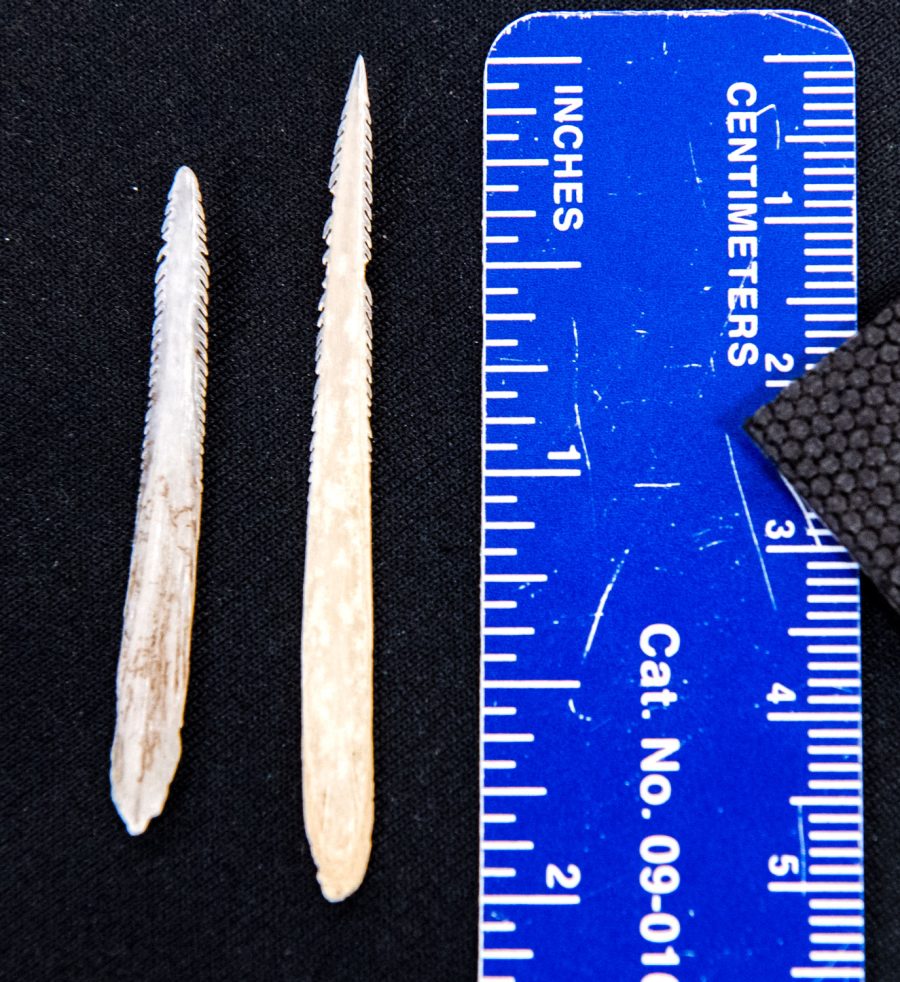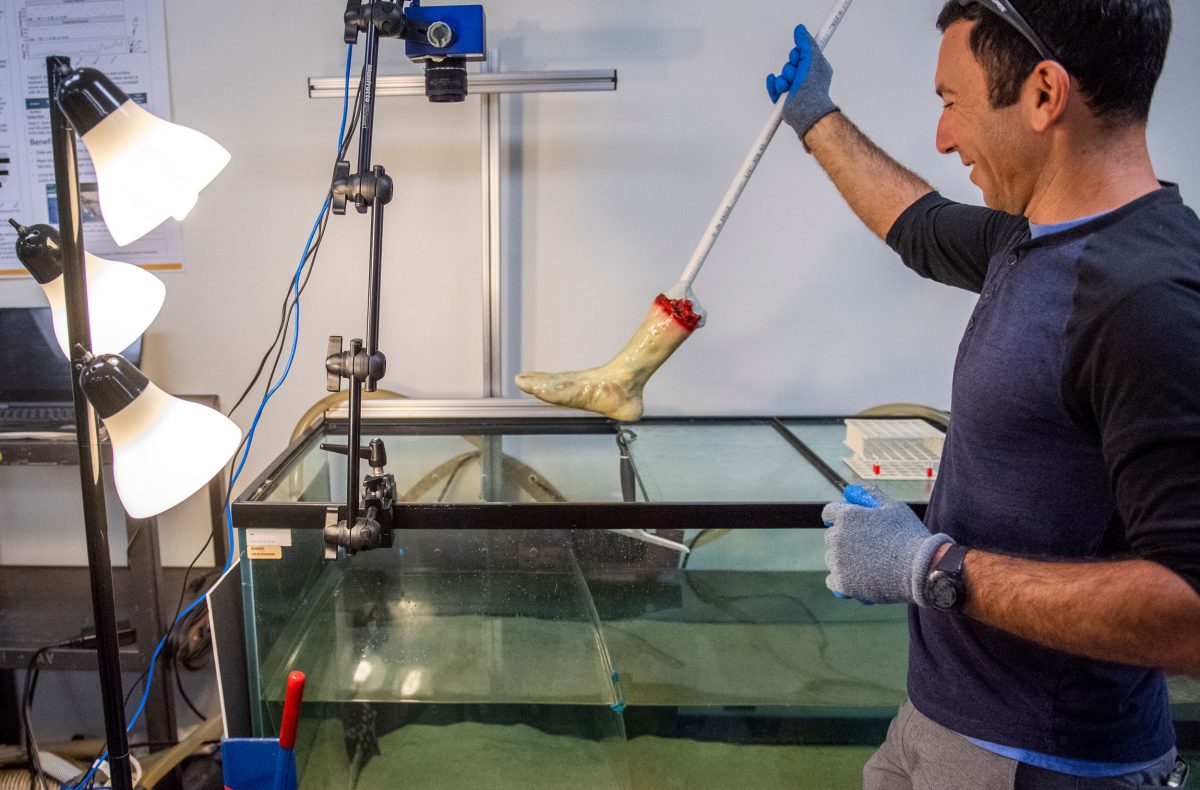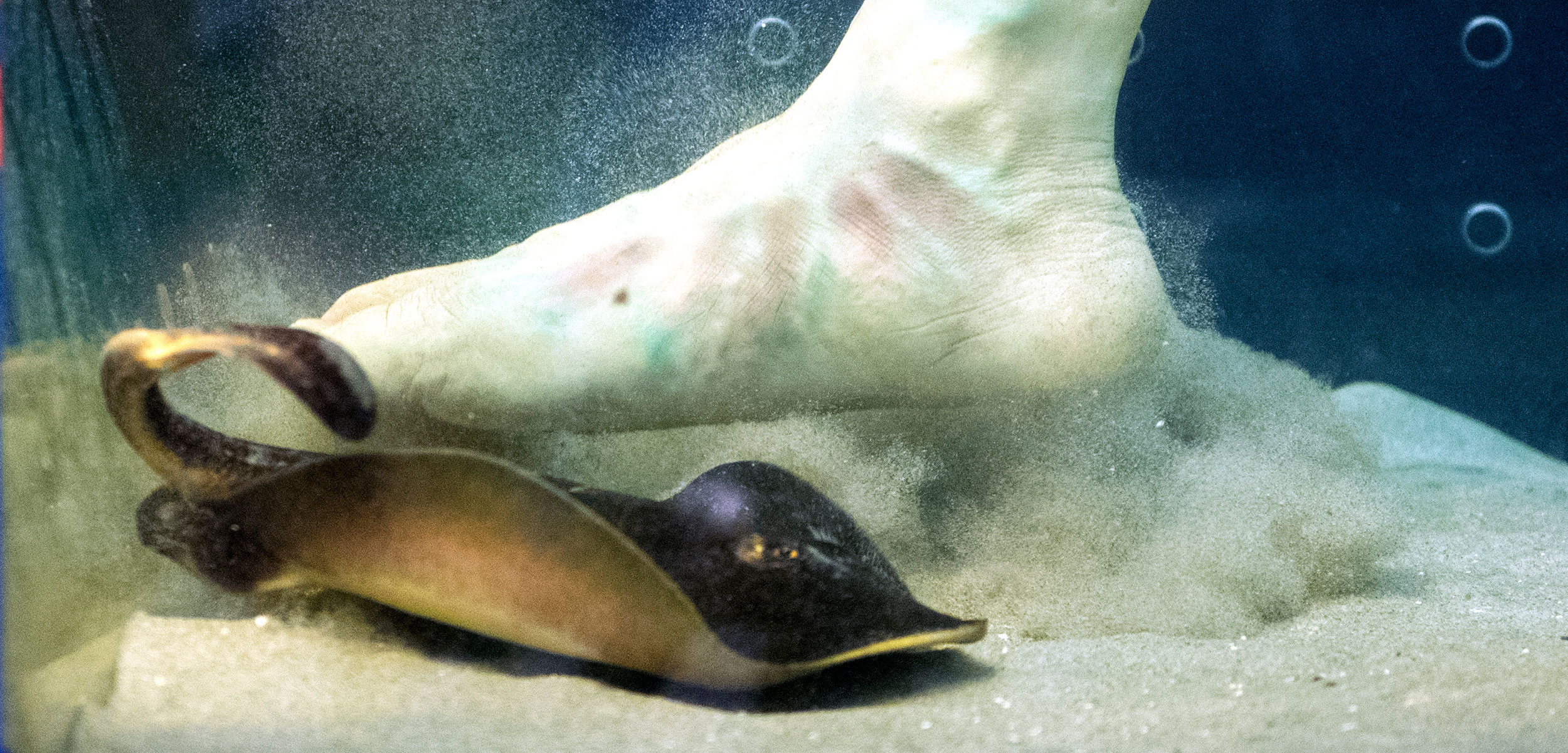A Step Forward in Stingray Science
A California researcher and his team simulate stepping on round rays to learn more about how, why, and when the animals strike.
Article body copy
Stingray 12 is surprisingly calm for an animal that’s getting squeegeed. The ray, roughly the size of a dinner plate, is submerged in the sand of a tank about the size of a chest freezer; even the golden eyes on top of her head are buried in the sediment. She stays motionless as researcher Ben Perlman of California State University, Long Beach, (CSULB) carefully pushes the sand from her mottled-brown body—the squeegee offering the scientist a little protection from the hazardous-looking barbs poking out halfway down Stingray 12’s tail.
“Sorry to bother you,” Perlman murmurs.
Six undergraduate students peer over his shoulder, and one, Carly Brenner, steps forward holding a 3D-printed silicone human foot glued to a PVC pipe.
“A little closer, a little closer,” Perlman coaches, as Brenner brings the foot centimeters from the stingray’s body. “Go for it,” he says, and Brenner takes aim at the stingray’s left pectoral fin, stamping down with the flexible foot.
The ray doesn’t move at all.
“No response,” Perlman says. The result will be logged into his lab’s study of what makes stingrays attack—science that Perlman hopes will eventually help people avoid painful stings from the serrated barbs, each about the length of an adult human’s big toe.
Perlman’s lab in Long Beach, California—aptly called STABB, for Stingray and Butterfly Biomechanics Lab (the butterfly project is currently paused)—explores how and why stingrays move and behave the way they do. Seal Beach, one of the city’s popular surf spots, five kilometers from the lab, is colloquially known as Ray Bay. Stingrays love to congregate there in the calm, warm waters at the mouth of the San Gabriel River, and lifeguards document upward of 500 painful stab injuries from rays each year. Studying the rays’ behavior and their stinging process can open a new window into human interactions with what the lab calls “danger pancakes,” Perlman says.
His research focuses on round rays—the most abundant ray species inhabiting California’s waters. Their behavior also makes them the most dangerous to unsuspecting passersby. While other rays quickly flee at the hint of danger, round rays stay buried in the sand and even hold their breath as a predator such as a juvenile great white shark—or a perceived predator such as a human—goes by, relying on their mottled color for camouflage. It’s this protective behavior that makes them far more likely to get stepped on and explains why the vast majority of stingray injuries in California are attributed to round rays, rather than the bat rays or diamond stingrays that also live in the area.
Stingray barbs are a kind of dermal denticle—like a tooth—on a tail that can be whipped around. In a strike, the animal releases a toxin from glandular cells at the base of one of the barbs. The toxin travels along a mucous coating and gets envenomated—injected—into the recipient through the puncture wound. Some ray species have barbs with serrated notches, which can make the barb stick into the skin of their attacker.

The serrated edge of a stingray’s barb can puncture and cling to a person’s skin. Photo by Thomas R. Cordova/Long Beach Post
Chris Lowe, a shark biologist who leads CSULB’s Shark Lab, estimates that about 10,000 people per year are injured by stingrays in Southern California. Round rays are like burger patties for juvenile white sharks, which is one of the reasons Lowe and his fellow shark scientists are keenly interested in stingray distributions and populations. The Shark Lab, established in the 1960s, has studied stingrays for years, but never their stinging mechanics.
Perlman, meanwhile, didn’t set out to research rays—he’s a fish biomechanist who studied how surfperch swim in kelp forests and how amphibious fishes in the tropics use their muscles to haul themselves out of the water. He also studied how birds’ wings can shapeshift during flight and how bullfrogs load up their tendons to increase their jumping power. In 2018, he took a job with CSULB as a teaching professor and left research for a few years.
Then, he got a knock on his door in the fall of 2021. Lowe had a question. He wanted to know if Perlman could help test a new material for surf booties developed by an inventor whose kids were afraid of rays, and a collaborator with expertise in materials science. Would the booties protect against stingray strikes, as designed? After receiving funds from an anonymous, surf-loving donor, Perlman hired a student, and together they collected rays from Seal Beach to serve as their test subjects.
To figure out if the material could protect against strikes, Perlman first had to understand the dynamics of the stingray’s defensive behavior. His initial research goal was to capture strikes on camera and use the footage to measure velocity and acceleration, which he could then use to calculate force. He bought a disembodied foot from the store Spirit Halloween, filled it with sand, and epoxied it onto a piece of plastic pipe to mimic a human foot for the trials. “That was a great jumping-off point,” Perlman says.
To learn more about what makes a ray decide to strike, he designed an experiment that divides the ray’s body into four different regions—midbody, left pectoral fin, right pectoral fin, and snout (basically equivalent to a nose). His team uses the zombie foot—which was upgraded to a 3D-printed silicone foot in 2023 because it’s more realistic—to “step” on the different parts of the body and record the animal’s reaction.

Ben Perlman started his experiments on round ray strikes using a Halloween zombie foot. He has since upgraded to a 3D-printed model. Photo by Thomas R. Cordova/Long Beach Post
The initial findings are stark: rays only strike if someone steps on their midbody, where all their organs are located. That makes them strike 85 percent of the time. Stepping on their sides just makes them swim away; a bop on the snout doesn’t elicit a reaction either. The findings are consistent, regardless of the ray’s size, age, or sex.
The lab has also been doing studies of the new material Lowe brought to Perlman—neoprene with a rubber composite lining—to see if it can stand up to the forces of a stingray strike. The researchers clip off barbs—akin to cutting off a fingernail, since the keratin-based barbs regrow within a few months—and use a machine to force them into the material with increasing pressure. So far, they have found the material to resist the force of most stingrays. (Another company hoping to create a ray-proof bootie is spinning out a product using a similar material this year.)
In addition to their barbs, some stingrays have large, thorny, scale-like denticles that provide passive protection, says Chris Martinez, a fish biologist at the University of California, Irvine, who studies stingray morphology. The thorns can pierce skin and make a predator’s life unpleasant, he says, but the stinger is something extra: a targeted weapon the animal can actively control to inflict damage.
Martinez says Perlman’s work is “really great and it’s definitely very relevant to cater to Southern California beachgoers.” He is planning to collaborate with Perlman in the future to investigate the neuromuscular underpinnings of the strikes.
The ultimate hope, Perlman says, is that the research will translate into best practices for people at the beach. For decades, surfers in Southern California have used a technique called the “stingray shuffle,” where they take tiny steps along the ground instead of big steps—to warn stingrays who might be buried in the sand.
Perlman says his experiments have scientifically backed up the stingray shuffle—when someone takes tiny steps, they are not going to come into contact with the midbody section of the ray, so they won’t be struck. Vibrations through the sand can also give the animal a chance to move to safety. “[The rays are] just going to escape or not respond,” Perlman says.

Perlman walks with student Trinity Lozano as she transports a ray between tanks. Photo by Thomas R. Cordova/Long Beach Post
He knows exactly what’s at stake. Last summer, he was holding down a ray’s tail with a net while using a scalpel to make small identifying notches on the animal’s body—which has to be redone every few months as the notches grow out—when his hand slipped and the fish’s tail whipped around and struck an artery on his wrist. Blood immediately squirted everywhere, and the pain was “a seven-and-a-half out of 10.” He used the only known treatment, which was to submerge his hand in hot water to denature the poison. It took nearly two hours for the pain to fade. His wrist still bears a scar.
The lab is now engaged in a flurry of research activity that can keep Perlman and his teammates busy for the rest of the decade. They are testing how the size of a foot impacts the likelihood of a stingray strike, to see if someone who is lighter and smaller is less likely to get stung. So far, foot size seems to have no impact on how a ray responds. In the coming months, they’ll repeat the stepping experiments in the dark and in different water temperatures. The lab is home to 18 rays, and the animals get at least two days off between experiments to make sure they don’t get conditioned.
The researchers are also in the midst of studying rays as they bury themselves in the sand to understand why and how the animals move sand particles around. Eventually, the lab will also use 3D imaging from microCT scans to look at the curvature, sharpness, and angle of serrations across different round ray barbs. That will help them understand variation within the species and even within an individual: sometimes, after being clipped, a barb will grow back in a different shape or size.
Sharks tend to loom larger than rays in the Californian consciousness, Martinez says. “Rays don’t get as much attention because they’re not as big, they don’t have the big teeth like some of the large sharks do,” he says. “But you’re more likely to be harmed by one of those than a big shark.” The stats prove his point: in 2022, 57 shark attacks occurred around the globe, and stingray injuries were likely in the tens of thousands.
After her encounter with the silicone foot, Stingray 12 gets a 10-minute break before her other pectoral fin is stepped on. Perlman watches as she buries herself back in the sand. It feels good to take a figurative step toward helping fellow Californians avoid stabs and stings, he says. Ultimately, if surfers and swimmers can use his research to avoid danger pancakes, everyone’s time at the beach—rays included—will be more harmonious.

